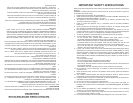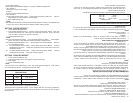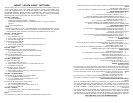RADIO OR TV INTERFERENCE
Operation of the microwave oven can cause interference to your radio, TV, or similar
equipment. When there is interference, it may be reduced or eliminated by taking the
following measures:
1. Clean door and sealing surface of the oven.
2. Reorient the receiving antenna of radio or television.
3. Relocate the microwave oven with respect to the receiver.
4. Move the microwave oven away from the receiver.
5. Plug the microwave oven into a different outlet so that microwave oven and receiver are
on different branch circuits.
UTENSILS GUIDE
This section lists which utensils can be used in the microwave, which ones have limited use
for short periods, and which ones should not be used in the microwave.
Recommended
·Microwave browning dish — Use to brown the exterior of small items such as steaks, chops,
or pancakes. Follow the directions provided with your browning dish.
·
Microwaveable plastic wrap — Use to retain steam. Leave a small opening for some steam
to escape and avoid placing it directly on the food.
·Paper towels and napkins — Use for short-term heating and covering; These absorb excess
moisture and prevent spattering. Do not use recycled paper towels, which may contain
metal and could ignite.
·Glass and glass-ceramic bowls and dishes — Use for heating or cooking.
·Paper plates and cups — Use for short-term heating at low temperatures. Do not use
recycled paper, which may contain metal and could ignite.
·Wax paper — Use as a cover to prevent spattering.
·Thermometers — Use only those labeled “Microwave Safe” and follow all directions. Check
the food in several places. Conventional thermometers may be used on microwave food
once the food has been removed from the oven.
Limited Use
·
Aluminum foil — Use narrow strips of foil to prevent overcooking of exposed areas.
Using too much foil can damage your oven, so be careful.
·Ceramic, porcelain, and stoneware — Use these if they are labeled “Microwave Safe”.
If they are not labeled, test them to make sure they can be used safely.
·Plastic — Use only if labeled “Microwave Safe”. Other plastics can melt.
·Straw, wicker, and wood — Use only for short-term heating, such as warming dinner rolls
for a few seconds. Baskets and bowls may be ammable.
Not Recommended
·Glass jars and bottles — Regular glass is too thin to be used in a microwave. It can shatter
and cause damage and injury.
·Paper bags — These are a re hazard, except for popcorn bags that are designed for
microwave use.
·Styrofoam plates and cups — These can melt and leave an unhealthy residue on food.
·Plastic storage and food containers — Containers such as margarine tubs can melt in the
microwave.
·Metal utensils — These can damage your oven. Remove all metal before cooking.
Note: Should you wish to check if a dish is safe for microwaving, place the empty dish in
the oven and microwave on HIGH for 30 seconds. A dish which becomes very hot
should not be used.
INTERFERENCIA DE FRECUENCIA RADIAL O
DE TV
El funcionamiento del horno puede generar interferencia en un radio, televisor o equipos
similares. Si hubiera interferencia, se puede tomar las siguientes medidas para reducirla o
eliminarla:
1. Limpie la puerta y la supercie hermética del horno.
2. Reoriente la antena receptora del radio o televisor.
3. Reubique el horno a microondas con respecto al equipo receptor.
4. Aleje el horno del equipo receptor.
5. Enchufe el horno a un tomacorriente distinto de tal manera que el horno y el equipo
receptor queden conectados a diferentes circuitos.
GUÍA DE UTENSILIOS
Esta sección detalla que utensilios pueden usarse con el horno a microondas, que utensilios
son de uso limitado y para períodos cortos, y que utensilios no deben usarse con este
horno.
Recomendados
- Plato para dorar en microondas - Utilice para dorar el exterior de alimentos de menor
tamaño tales como bistés, chuletas o panqueques. Siga las instrucciones que vengan con
el plato para dorar.
- Envoltura plástica para microondas - Utilice para mantener el vapor. Dejé una pequeña
abertura para que algo de vapor pueda escapar y evite colocarla directamente sobre los
alimentos.
- Toallas y servilletas de papel - Utilice para calentar durante períodos cortos y para cubrir.
Estas absorben el exceso de humedad y evitan las salpicaduras. No utilice toallas de papel
recicladas ya que pueden contener trozos de metal que podrían prenderse fuego.
- Recipientes y platos de vidrio y de cerámica - Utilice para calentar y para cocer.
- Platos y vasos de papel - Utilice para calentar durante períodos cortos a temperaturas
bajas. No utilice papel reciclado ya que puede contener trozos de metal que podrían
prenderse fuego.
- Papel acerado - Utilice para cubrir y evitar salpicaduras.
- Termómetros - Utilice sólo aquellos diseñados para utilizar en uno horno a microondas y
siga todas las instrucciones. Revise los alimentos en diversos lugares. Los termómetros
convencionales pueden usarse con los alimentos cocidos a microondas una vez que hayan
sido retirados del horno.
Uso limitado
- Papel aluminio - Utilice tiras delegadas de papel aluminio para evitar la cocción excesiva
de algunas áreas expuestas. El uso excesivo de papel aluminio puede dañar su horno, así
que tenga cuidado.
- Recipientes de cerámica, porcelana y barro - Utilice solamente si son para uso en horno
a microondas. Si no lo son, pruébelos para asegurarse de que puedan usarse de manera
segura.
- Plástico – Utilice sólo si es para uso en horno a microondas. Otros tipos de plástico pueden
derretirse.
- Paja, mimbre y madera - Utilice solamente para calentar durante períodos cortos, por
ejemplo para calentar panecillos durante algunos segundos. Las canastas y recipientes de
estos materiales pueden ser inamables.
No recomendados
- Frascos y botellas de vidrio - El vidrio común y corriente es demasiado delgado para ser
usado en uno horno a microondas. Puede trozarse y causar daños y lesiones.
- Bolsas de papel - Éstas son propensas a prenderse fuego, excepto las bolsas de palomitas
de maíz que están diseñadas para uso en microondas..














